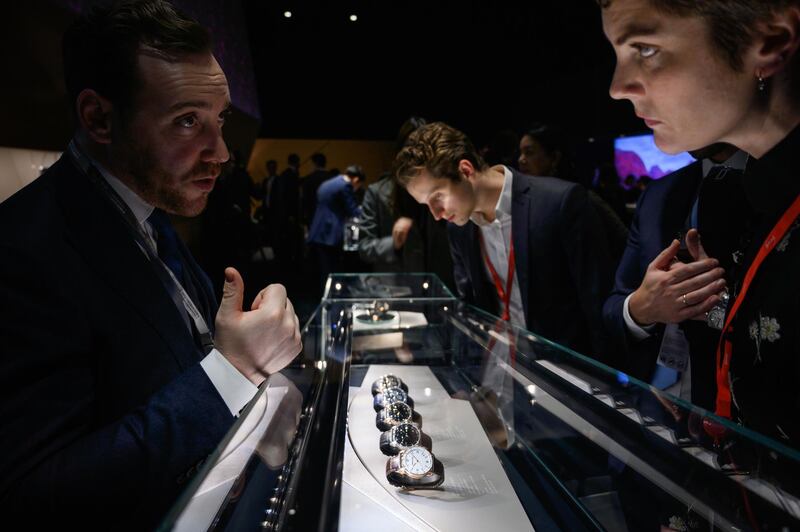Audemars Piguet spent the last seven years designing a new family of wrist watches, heralding its most important product launch in decades as a bold move beyond the Royal Oak timepiece that the company has long relied on for the bulk of its sales. The online reaction was swift and brutal: It’s a dud.
The “Code 11:59” collection aims high, starting at 25,000 Swiss francs (Dh93,500) and going up to 295,000 francs. Audemars plans to make 2,000 watches in the first year and said it hopes the Code 11:59 will eventually make up at least 20 per cent of its portfolio.
That’s an audacious target, given the initial response from a stunned watch community, which had become accustomed to Audemars doing little more than churning out updates of the Royal Oak through the years. The company’s Instagram feed overflowed with hundreds of comments that decried the design as bland and uninspiring. Before they had even seen it in person, critics likened the watch to cheap fashion timepieces that no serious connoisseur would let near their wrist. Turd emojis were in high demand, all-cap swearing was commonplace, and the puns (‘the Royal Joke’) flowed freely.
“At best, the dial on the new three-hander is sleek and modern,” reviewer Zach Pina wrote in a comparison of two models on the popular “A Blog to Watch” website. “At worst, neither dial design really challenges the viewer – they feel safe and trendy, and not the type of disruptive stuff that solidified AP in the pantheon of modern luxury watchmaking.”
A few people commended Audemars for daring to invest in a new family of watches, and lauded the unusual design of the watch case with its round and octagonal elements or the double-curved crystal glass for better legibility. Others said that the watch was growing on them, and that the true aesthetic test would come on the wrist, rather than in online photos.
Audemars Chief Executive Officer François-Henry Bennahmias said the Code 11:59 was intended to prove that the company can move beyond the Royal Oak. “We encourage people to come and try the watch, see it in real instead of just looking at pictures,” Mr Bennahmias said. “People will judge for themselves.”
The watches in the new collection are slender and buck the trend of ever-bigger dials, opening the brand to a clientele for whom the Royal Oak look was too rugged and making it more accessible to women and men with slim wrists.
Still, the overall tone of the responses was harsh, injecting a dose of drama into this year’s Geneva watch salon, where Audemars on Monday presented the new lineup. It’s also a study in the perils of trying to move beyond a highly successful product. Cartier a few years ago tried to push its watch portfolio into more complicated and expensive offerings, a move that backfired because customers preferred the simple, elegant designs of its older models.
While most watch brands have signature timepieces - think the Submariner for Rolex, the Speedmaster for Omega, or the Nautilus for Patek Philippe - no other high-end house is as closely linked to a single design as family-owned Audemars Piguet. The Royal Oak was conceived by legendary designer Gerald Genta in the early 1970s, and it broke new ground with its unusual octagonal shape and its stainless steel case rather than the gold that was typical of watches in that price range. It became a massive hit for Audemars and spawned multiple variants as well as a chunkier sibling called the Royal Oak Offshore.
_______________
Read more:
[ Race to the runway: the other side of Lewis Hamilton ]
[ Sotheby's Dubai hosts first watch auction - in pictures ]
_______________
The watch industry is brimming with die-hard enthusiasts willing to fork over the price of a car or even a house for a piece of metal that doesn’t even tell time as efficiently as quartz models costing less than $20. Major product launches are closely watched and generate feverish comments on social media. But there’s little precedent to the storm of rancor that Audemars unleashed with the Code 11:59. The collective outcry was akin to Ferrari deciding to branch out into camper vans or Chanel opening a pop-up store in a discount supermarket.
Of course, even the Royal Oak or Patek’s Nautilus, also designed by Genta, needed time to find a loyal customer base because they were so different from competitors’ offerings. But the social-media onslaught for the Code 11:59 reveals the mixed blessing of the promotional channels available today: while companies reach a much larger audience, the backlash can also be far more ferocious and widespread than it was a few years ago.
“Social media has changed the way we speak to the consumer,’’ said Davide Traxler, CEO of rival watchmaker Parmigiani Fleurier. “It’s great news, because you have to listen, and at the same time it’s challenging.”






